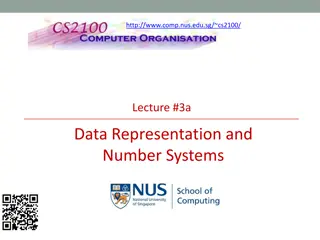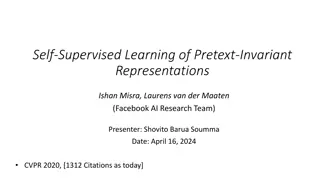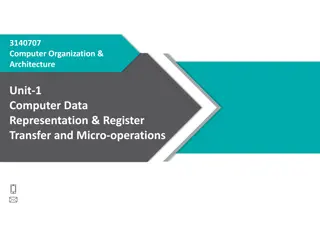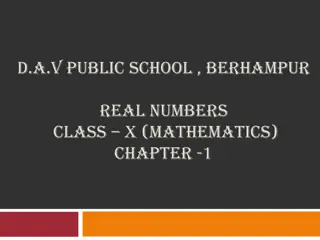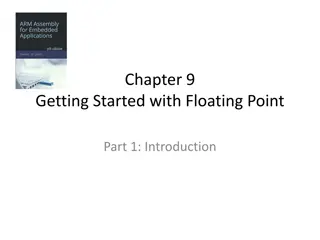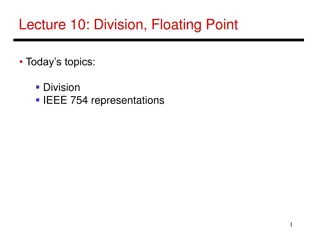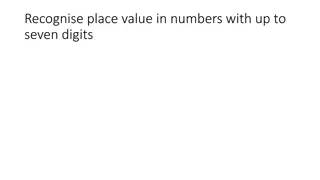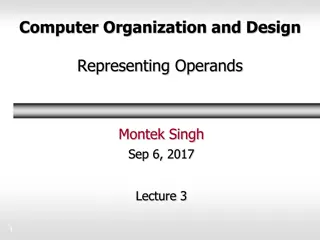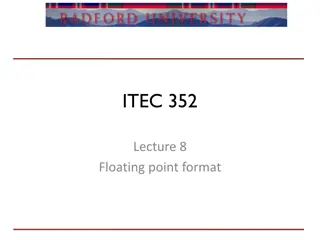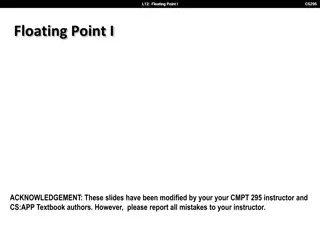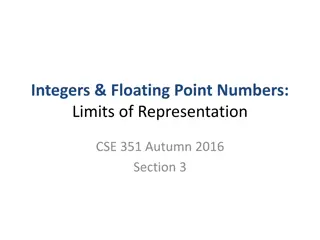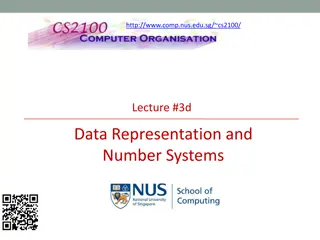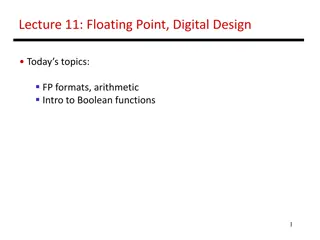Understanding Number Representations and Floating-point Numbers in Computer Science
Exploring the conversion of integers to binary, including the 2's complement method for negative numbers. The concept of fractions in binary and the representation of floating-point numbers in single and double precision formats are also discussed. Special cases like denormalized numbers, infinity, and NaN are considered, along with a problem involving single precision floating-point number representation. The MIPS architecture and its registers and instructions are briefly introduced as well.
Download Presentation

Please find below an Image/Link to download the presentation.
The content on the website is provided AS IS for your information and personal use only. It may not be sold, licensed, or shared on other websites without obtaining consent from the author. Download presentation by click this link. If you encounter any issues during the download, it is possible that the publisher has removed the file from their server.
E N D
Presentation Transcript
Interger Number Representations To convert an unsigned decimal number to binary: you divide the number N by 2, let the remainder be the first digit. Then divide the quotient by 2, then let the remainder be d1, then divide the quotient by 2, then let the remainder be d2, until the quotient is less than 2. 2 s complement. To convert a negative number to binary: invert each bit, and then add 1.
Problem The binary representation of -57ten in 8 bits in 2 s complement is (a) 11000111 (b) 10011111 (c) 11010111 (d) None of the above.
Number with Fractions Numbers with fractions. Convert the integer part and the fraction part to binary separately, then put a dot in between. To get the binary representation of the fraction, divide the fraction first by 0.5 (2-1), take the quotient as the first bit of the binary fraction, then divide the remainder by 0.25 (2-2), take the quotient as the second bit of the binary fraction, then divide the remainder by 0.125 (2- 3), Floating numbers. Single precision. 32 bits.
Floating Numbers Single precision. 32 bits. 127 ) 1 1 ( + (2 Exponent ) S ( . 0 Fraction ) Double precision. 64 bits. Bias is 1023. 31 30 29 28 27 26 25 24 23 22 21 20 19 18 17 16 15 14 13 12 11 10 9 8 7 6 5 4 3 2 1 0 s Exponent fraction 1 bit 11 bits 20 bits Fraction (continued) 32 bits
Special Cases Considered Single precision Double precision Object represented Exponent Fraction Exponent Fraction 0 0 0 0 0 denormalized number 0 nonzero 0 nonzero floating-point number 1-254 anything 1-2046 anything infinity 255 0 2047 0 255 nonzero 2047 nonzero NaN (Not a number)
Problem The single precision floating number representation of -22.75ten is (a) 1 10000111 011 0100 0000 0000 0000 0000 (b) 1 10000011 011 0110 0000 0000 0000 0000 (c) 0 10000100 011 1110 0000 0000 0000 0000 (d) None of the above.
MIPS MIPS registers
MIPS MIPS instructions (not complete) R-type: add, sub, and, or, sll, add $t0, $t1, $t2 # add $1, $t2, put the result in $t0 Memory: lw, sw, lb, sb. lw $t0, 4($t1) # read the data at the address of # $t1+4, put it in $t0 Branch: beq, bne, beq $t0, $t1, SOMEWHERE # if $t0 is equal to $t1, the # next instruction to be # executed is at the address # specified by SOEMWHERE # (PC+4+offset) Jump: j, jal, jr j SOMEWHERE # the next instruction should be at the address # specified by SOMEWHERE (The upper 4 bits from PC+4, the # lower 26 bits from the instruction, the last 2 bits 0) Immediate type: addi $t0, $t0, 4 # add $t0 by 4 and put it in $t0
MIPS Instruction Encoding Each MIPS instruction is exactly 32 bits R-type (register type) I-type (immediate type) J-type (jump type) op op rs rs rt rt rd 16 bit address or constant shamt funct op 26 bit address
MIPS Coding If else. Assume f to h are in $s0 to $s4.
while loop Assume that i and k correspond to registers $s3 and $s5 and base array save is in $s6 9/15/2024 week04-3.ppt 12
Problem If $t0 is holding 0, $t1 is holding 1, what will be the value stored in $t2 after the following instructions? srl $t1, $t1, 1 bne $t0, $t1, L1 addi $t2, $t0, 1 L1: addi $t2, $t0, 2 (a) 1. (b) 2. (c) 3. (d) None of the above.
(b) L1: Exit: Consider the following C code bgt $t0, $t1, L1 add $t2, $t0, $s0 sw $t1, 0($t2) j Exit add $t2, $t1, $s0 lw $t0, 0($t2) if (a > b) a = A[b]; else A[a] = b; where A is an integer array. Which of the following correctly implements the code above, assume a is in $t0, b is in $t1, and the starting address of A is in $s0? (bgt is branch if greater than. ) (c) L1: Exit: bgt $t0, $t1, L1 sll $t2, $t0, 2 add $t2, $t2, $s0 lw $t1, 0($t2) j Exit sll $t2, $t1, 2 add $t2, $t2, $s0 sw $t0, 0($t2) (a) bgt $t0, $t1, L1 add $t2, $t0, $s0 lw $t1, 0($t2) L1: add $t2, $t1, $s0 sw $t0, 0($t2) Exit: (d) None of the above.
MIPS Function jal Funct: The next instruction will be at address specified by Funct PC+4 will be stored in $ra jr $ra: The next instruction will be the one at address equal to the content in $ra Calling a function is more like going to a function and then come back
.data array: msg_done: main: loop: .word 12, 34, 67, 1, 45, 90, 11, 33, 67, 19 .asciiz "done!\n" .text .globl main la $s7, array li $s0, 0 #i li $s1, 0 #res li $s6, 9 sll $t0, $s0, 2 add $t0, $t0, $s7 lw $a0, 0($t0) lw $a1, 4($t0) jal addfun add $s1, $s1, $v0 addi $s0, $s0, 1 beq $s0, $s6, done j loop done: addfun: li $v0,4 la $a0,msg_done syscall jr $ra add $v0, $a0, $a1 jr $ra
Problem Consider the following code segment. What will the code do? li $ra, 0x04000000 jal f1 other instructions f1: addi $ra, $ra, -8 jr $ra (a) It will enter a loop and can never come out. (b) It will jump to the instruction located at address 0x04000000. (c) It will call f1 once, then continue to execute other instructions following the jal f1 instruction. (d) None of the above.
MIPS Calling Conventions MIPS assembly follows the following convention in using registers $a0 - $a3: four argument registers in which to pass parameters $v0 - $v1: two value registers in which to return values $ra: one return address register to return to the point of origin 9/15/2024 week04-3.ppt 18
MIPS stack The stack in MIPS is a memory space starting at 0x7ffffffc and growing DOWN. The top of the stack is always pointed by the stack pointer, $sp (the address of the first element space in the stack should always be in $sp). A function should save the registers it touches on the stack before doing anything, and restore it before returning.
MIPS Calling Conventions - more MIPS software divides 18 of the registers into two groups $t0 - $t9: 10 temporary registers that are not preserved by the callee on a procedure call These are caller-saved registers since the caller must save the ones it is using $s0 - $s7: 8 saved registers that must be preserved on a procedure call These are callee-saved registers since the callee must save the ones it uses In general, if there is a register that the callee may change, and the caller still needs it after calling the callee, the caller should save it and restore it before using it, such as $ra. If there is a register that the caller is not expected to change after calling the callee, the callee should save it, such as $s0. 9/15/2024 week04-3.ppt 20
Saving $s0 9/15/2024 week04-3.ppt 21
MIPS interrupt For external interrupt, your code is executing, and if an event happens that must be processed, The address of the instruction that is about to be executed is saved into a special register called EPC PC is set to be 0x80000180, where the interrupt handlers are located Then, after processing this interrupt, call eret to set the value of the PC to the value stored in EPC Note the difference between an interrupt and a function call. In a function call, the caller is aware of going to another address. In interrupt, the main program is not.
Supporting floating point. Load and Store Load or store from a memory location (pseudoinstruction ). Just load the 32 bits into the register. l.s $f0, val s.s $f0, val Load immediate number (pseudoinstruction ) li.s $f0, 0.5
Arithmetic Instructions abs.s $f0, $f1 add.s $f0, $f1, $f2 sub.s $f0, $f1, $f2 mul.s $f0, $f1, $f2 div.s $f0, $f1, $f2 neg.s $f0, $f1
Data move mov.s $f0, $f1 mfc1 $t0, $f0 mtc1 $t0, $f0
Convert to integer and from integer cvt.s.w $f0, $f0 # convert the 32 bit in $f0 currently representing an integer to float of the same value cvt.w.s $f0, $f0 # the reverse
Comparison instructions c.lt.s $f0,$f1 #set a flag in coprocessor 1if $f0 < $f1, else clear it. The flag will stay until set or cleared next time c.le.s $f0,$f1 #set flag if $f0 <= $f1, else clear it bc1t L1 # branch to L1 if the flag is set bc1f L1 # branch to L1 if the flag is 0
Read the MIPS code and answer the following questions. What does function fun do? What is the value returned in $v0 after the function is called?


